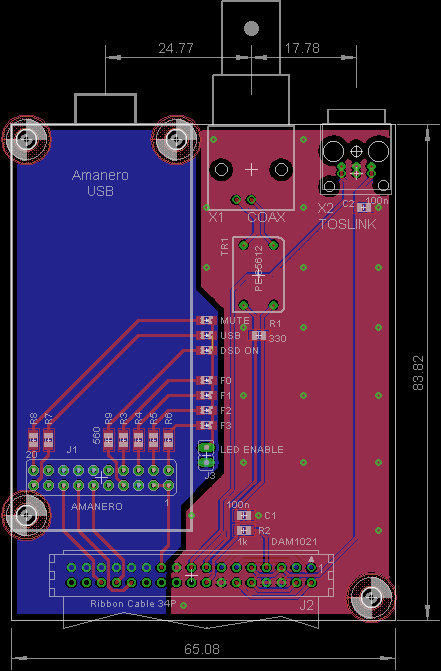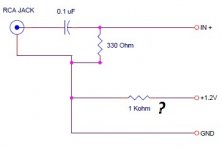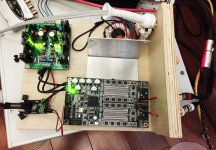I wouldn't remove the 330R, it's still needed as the LVDS receiver is 100R input impedance and SPDIF is 75R....
Thanks Soren
I'm considering making my own inputs board and I'm thinking of 2 x coax and 2 x toslink. Regarding the toslinks, I believe that I can switch between them using a 7SB3257.
Regarding the coax'es, what would be a proper switching scenario? Using two independent pulse transformers and switching (again using 7SB3257s) both of the signal lines before the +1.2V "injection"?
Regarding the coax'es, what would be a proper switching scenario? Using two independent pulse transformers and switching (again using 7SB3257s) both of the signal lines before the +1.2V "injection"?
And lastly an observation on noise coupling through the isolated I2S connections. I was checking the DAC outputs with a scope to see if there is any high frequency noise present. There is no noise from the DAC itself, but there is some high requency noise at the outputs of the DAC when USB is powered on.
Here is output noise with USB hub powered off. It is pretty much the noise of the scope itself.

And here is output noise when USB is powered on:

This noise is present regardless of whether the dac itself is powered on or off. It shows that even though the isolators do break ground loops, some HF noise will get through. Don't know if it has a noticeable effect on sound quality, just something to think about.
Can anyone try to confirm this observation.
I tried to reproduce that and failed. That reason might be my, now a bit old, analog oscilloscope, a Tek 2465B.
But as the above signal looks periodic and is in a range that can be perfectly handled by it, I assumed I would see something.
First if the DAC is off, I get a next to nil signal independent is USB is attached or not.
If the DAC is running and I attach USB the level rises for about one second and then returns to the same level as before.
The USB signal came from a battery powered laptop.
Having Amanero option for input board would be great.
I am considering simple u.fl pads for the Amanero (or whatever I2S source). Better yet, I'm considering a simple mux so that 2 x I2S sources are supported.
Søren,
Could you show an appropriate setup for using a balanced isolation transformer for AES/EBU SPDIF input. You showed a great one for the unbalanced SPDIF, including a bias current. Do you have something similar for balanced input?
I guess to answer my question, the side of the transformer facing the DAC stays the same as your singled ended input schematic, and the other side has the 2 windings for balanced?
Could you show an appropriate setup for using a balanced isolation transformer for AES/EBU SPDIF input. You showed a great one for the unbalanced SPDIF, including a bias current. Do you have something similar for balanced input?
I guess to answer my question, the side of the transformer facing the DAC stays the same as your singled ended input schematic, and the other side has the 2 windings for balanced?
I have been thinking about it myself, and it does seem unlikely that such noise would pass through the entire unpowered dac board. The period of that noise looks suspiciously similar to I2S BCLK line transition frequency, maybe that is the actual source and it got coupled into the outputs as RFI. I will reexamine the setup when I have more time to play with it.Can anyone try to confirm this observation.
I tried to reproduce that and failed.
are u saying if the source had a clean enough power supply that this unease in the sound of the dam dac will be gone?
not that I disagree upstream has a profound influence on sound quality mostly due to power supplies just not sure it would change my opinion of one dac vs another
Hey nige2000!
Based on the feedback and measurements presented so far, I think that getting the best out of this DAC will require attention in several areas in addition to the upstream source. I don't think that an optimized source will be sufficient by itself, but will play an important part. My goal with that posting was to suggest that relying only on the isolation and reclocking is likely not sufficient for ensuring the best results from a given source and offering support for normundss' measurements.
My plan for getting the best sound out of it that I can include:
1. Using an optimized computer source with a fairly low-noise I2S feed (highly-modified ESI Juli@).
2. Stout and solid power supplies for the DAM with high-grade regulation before feeding DAC, bypassing the diode bridge.
3. Taking the direct output to a off-board output stage, again with its own stout and solid power supplies.
4. Participating in the filter experimentation and hopefully that effort will develop better-sounding filter alternatives.
To me, the reports so far sound promising and worthwhile of experimentation. And I'm open to other areas to consider to get the best sound out of the device. My goal is to see how far it can go without modifying the board (not that I am above that).
And Soren, my many thanks for developing & producing this!
Greg in Mississippi
why julia@ not usb to i2s?Hey nige2000!
Based on the feedback and measurements presented so far, I think that getting the best out of this DAC will require attention in several areas in addition to the upstream source. I don't think that an optimized source will be sufficient by itself, but will play an important part. My goal with that posting was to suggest that relying only on the isolation and reclocking is likely not sufficient for ensuring the best results from a given source and offering support for normundss' measurements.
My plan for getting the best sound out of it that I can include:
1. Using an optimized computer source with a fairly low-noise I2S feed (highly-modified ESI Juli@).
have you a link to the julia@ mods your thinking of?
no doubt2. Stout and solid power supplies for the DAM with high-grade regulation before feeding DAC, bypassing the diode bridge.
funny i got more sq out of replacing the 3.3v power than i did bypassing the bridge
looking forward to the filter options3. Taking the direct output to a off-board output stage, again with its own stout and solid power supplies.
4. Participating in the filter experimentation and hopefully that effort will develop better-sounding filter alternatives.
To me, the reports so far sound promising and worthwhile of experimentation. And I'm open to other areas to consider to get the best sound out of the device. My goal is to see how far it can go without modifying the board (not that I am above that).
And Soren, my many thanks for developing & producing this!
Greg in Mississippi
Thanks Eldam! Now I understand.You must add a 0.1 uF minimum cap (film or ceramic) between rca and spidf in+ (but if you are absolutly sure than your streamer has already one before or after its pulse transformer in serie on the signal : if any doubt put the 0.1 uF cap or more in serie - DC pulse signal must be avoided and a pulse transformer is not enough here-)
Thanks Soren!I wouldn't remove the 330R, it's still needed as the LVDS receiver is 100R input impedance and SPDIF is 75R....
So it looks like this?:
Do I need the 1K resistor?
Attachments
Soren,
Is it possible to bypass/pass offical power input and direcly feed to 3.3v and 1.2v (for fpga maybe) to the relative sections?
No.
I have drawn up a version of an input board for Amanero, BNC Coax and TOSLINK inputs, but am now rethinking that TOSLINK should be powered from a separate supply. Maybe I will also add provisions for putting small inductors or ferrite beads on I2S lines from Amanero - just to see if that HF noise can be reduced without completely destroying the signal shape. On a non-reclocking DAC it would be a no-no, but FIFO reclocker should be fairly tolerant of such a thing.
The input board uses a 34 pin ribbon connector, of which 26 pins would be connected to J3 , two pins for tapping into 1.2V, and 6 wires going to front panel for input selection and volume control.

This is by far the input card i liked best so far. BUT the thing with 34/26 pin ribbon connector seems less good.. i would rather like it to fit with 26pin female straight over the dac input. I would rather put the other extra 8 pins in a separate connector to the side.
Doesn't that seem a bit better to do?
I will certainly buy any of the input PCB's myself, and i like this one the best (since i have the Amanero board, and it would be really simple with this board).
This or the emyeuoi pcb looks great!
@ Nige2000,
Have you some pictures and description on how you bypassed the PS ? If you want not to "pollute" the official vendor stock dam1021 thread to not mix layout tweak here, you can use the implementation thread I opened in the digital in : it is made for everybody who want to work around dam1021 (PS, output, boxing, parts reference, etc).
@ Greg, ) subscribed)
) subscribed)
I don't know the capacity in nano or milli second of the FIFO (and have a poor understanding about that), but why not start instead with a short usb to I2S close to the dam1021 instead a long I2S connection which are not made for that (despite the fifo)
As Paul (Spzzzzkt member) said: a little output transformer could had some harmonics which can be a trade off for red books materials ? A little stereo Lundhal output traffo with mu sheilding and separation/isolation between windings (around 65 euros) ?
Is it possible to make some EQ in the audio band for everyone subjective taste with a streamer like Foobar if used as player and staying with the embeded FIR filters ?
@ Soren
Does the .skr file you gave the one of your second revision to allow people to work on it or the stock filter from sox one have to upload in the dam1021 to try ?
Have you some pictures and description on how you bypassed the PS ? If you want not to "pollute" the official vendor stock dam1021 thread to not mix layout tweak here, you can use the implementation thread I opened in the digital in : it is made for everybody who want to work around dam1021 (PS, output, boxing, parts reference, etc).
@ Greg,
I don't know the capacity in nano or milli second of the FIFO (and have a poor understanding about that), but why not start instead with a short usb to I2S close to the dam1021 instead a long I2S connection which are not made for that (despite the fifo)
As Paul (Spzzzzkt member) said: a little output transformer could had some harmonics which can be a trade off for red books materials ? A little stereo Lundhal output traffo with mu sheilding and separation/isolation between windings (around 65 euros) ?
Is it possible to make some EQ in the audio band for everyone subjective taste with a streamer like Foobar if used as player and staying with the embeded FIR filters ?
@ Soren
Does the .skr file you gave the one of your second revision to allow people to work on it or the stock filter from sox one have to upload in the dam1021 to try ?
Last edited:
Some initial impression after playing with the DAC for the past two days.
My setup is JRiver 20 (WASAPI) --> Mac mini (Win 7) --> Toslink --> R2R DAC --> The Wire Headphone amp --> Balanced HD800
For comparison, I have JRiver 20 (WASAPI) --> Mac mini (Win 7) --> Toslink --> Buffalo II --> The Wire Headphone amp --> Balanced HD800
Both R2R DAC and Buffalo II are powered by Placid Bipolar HD shunt regulators from Twisted Pear Audio. The Toslink module in the picture below has its own 3.3V onboard regular that takes in 12V from the shunt regulator. SE output connected to The Wire headphone amp using SE-BAL converter. The headphone amp use OPA1632 which as 3V maximum input voltage, so I know I am not overloading the headphone amp.
The setup was extremely easy, probably the easiest DIY I have done. It worked flawlessly on the first try. Thank you Soren for such a beautiful design!
Now for sound quality, I agree with a lot of the things people have said before. There's very obvious grain when listening to 44.1k material. The higher the sampling rate, the better it gets. At 96K, the grain becomes much less noticeable but still there. It has this shouting quality when volume goes higher, again, less with higher sampling rate. The Buffalo II sounds more spacious, and smoother in comparison, the sound stage is also more cohesive. I really hope a new filter will fix these issues, as there are things I really like about the R2R DAC. First, it sounds more full bodied compare to the Buffalo II. I never thought the Buffalo II is thin until I compared to the R2R. And bass is also more impactful. The bass part is very obvious when listening to the first 20 seconds of My One and Only Love from Jazz Prologue III. The R2R portraits the tones of instruments in a more accurate way, it sound more real for lack of better words.
Given that the filter is programmable I have high hope that this DAC will eventually replace my Buffalo II.
My setup is JRiver 20 (WASAPI) --> Mac mini (Win 7) --> Toslink --> R2R DAC --> The Wire Headphone amp --> Balanced HD800
For comparison, I have JRiver 20 (WASAPI) --> Mac mini (Win 7) --> Toslink --> Buffalo II --> The Wire Headphone amp --> Balanced HD800
Both R2R DAC and Buffalo II are powered by Placid Bipolar HD shunt regulators from Twisted Pear Audio. The Toslink module in the picture below has its own 3.3V onboard regular that takes in 12V from the shunt regulator. SE output connected to The Wire headphone amp using SE-BAL converter. The headphone amp use OPA1632 which as 3V maximum input voltage, so I know I am not overloading the headphone amp.
The setup was extremely easy, probably the easiest DIY I have done. It worked flawlessly on the first try. Thank you Soren for such a beautiful design!
Now for sound quality, I agree with a lot of the things people have said before. There's very obvious grain when listening to 44.1k material. The higher the sampling rate, the better it gets. At 96K, the grain becomes much less noticeable but still there. It has this shouting quality when volume goes higher, again, less with higher sampling rate. The Buffalo II sounds more spacious, and smoother in comparison, the sound stage is also more cohesive. I really hope a new filter will fix these issues, as there are things I really like about the R2R DAC. First, it sounds more full bodied compare to the Buffalo II. I never thought the Buffalo II is thin until I compared to the R2R. And bass is also more impactful. The bass part is very obvious when listening to the first 20 seconds of My One and Only Love from Jazz Prologue III. The R2R portraits the tones of instruments in a more accurate way, it sound more real for lack of better words.
Given that the filter is programmable I have high hope that this DAC will eventually replace my Buffalo II.
Attachments
why julia@ not usb to i2s?
have you a link to the julia@ mods your thinking of?
The computer source I'm planning to use has a highly slimmed-down Windows XP and cMP/cPlay setup. The entire Op System, player, GUI, and Juli@ driver are on a <15Mb load. USB functionality is entirely removed, along with anything else not needed to run that setup.
The Juli@ mods are my own. It only uses the digital section and they include:
1. Cutting the PCI power and running it from a separate linear supply.
2. Adding additional bypass capacitors at each chips power feed... almost 2000uf added there. Caps are chosen to some extent by location, with PPS caps used instead of ceramic where they made a difference.
3. Separate modified Dexa regulators for the 5v and 3.3v rails on the card along with additional capacitance at the input and outputs of the regulators.
4. Disabling or removing non-used chips.
This took several iterations to get to where I was satisfied. I can provide you details off the list if you want. I never published it after I realized it took really good skills doing manual SMD soldering... above what I suspect most can do.
looking forward to the filter options
Ditto. I think there's a lot of untapped potential here in just playing with filters.
Greg in Mississippi
@ Soren
Does the .skr file you gave the one of your second revision to allow people to work on it or the stock filter from sox one have to upload in the dam1021 to try ?
Those files are the stock factory filters. The .txt is the starting point for experienced dsp persons to work on....
- Home
- Vendor's Bazaar
- Reference DAC Module - Discrete R-2R Sign Magnitude 24 bit 384 KHz

